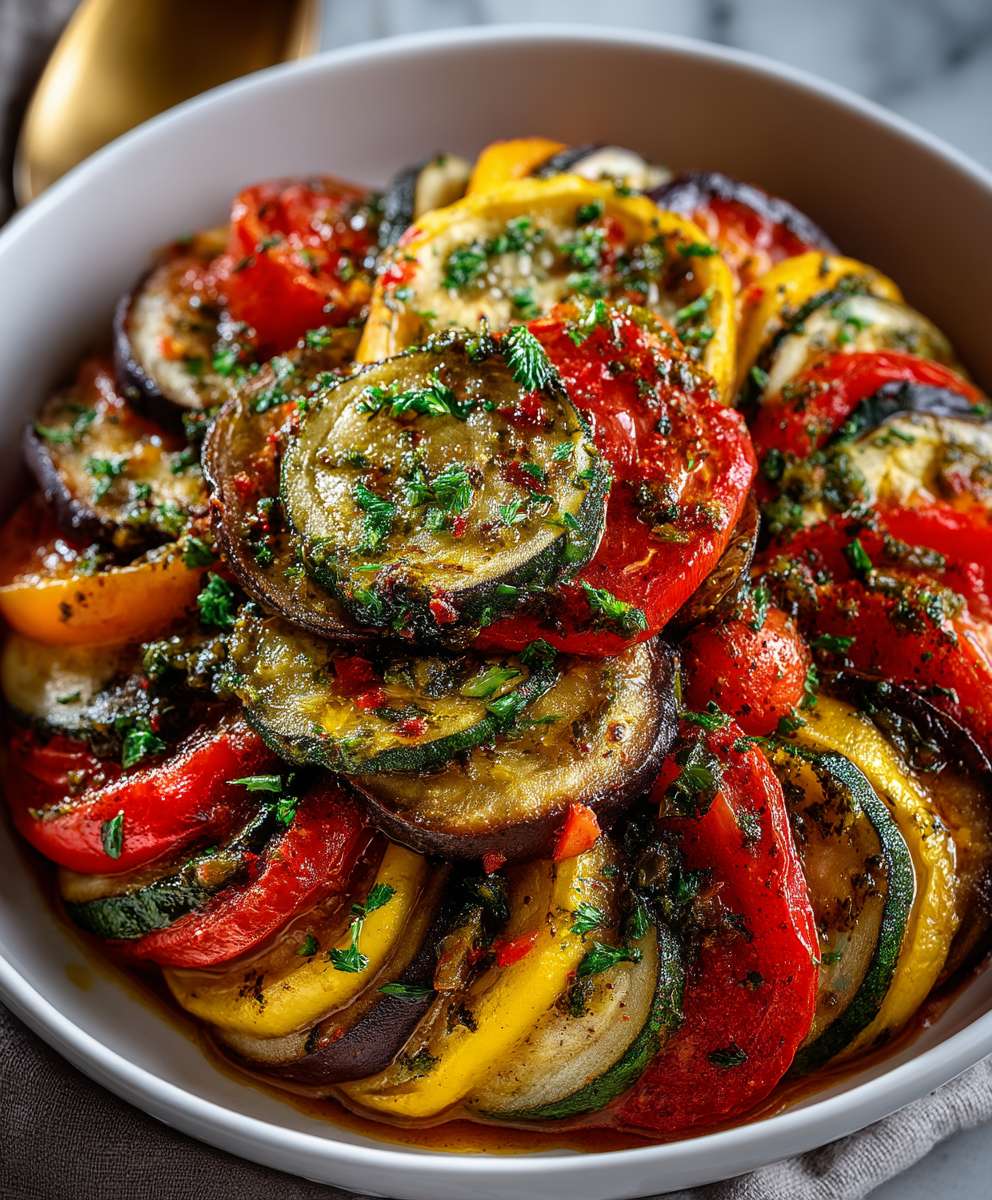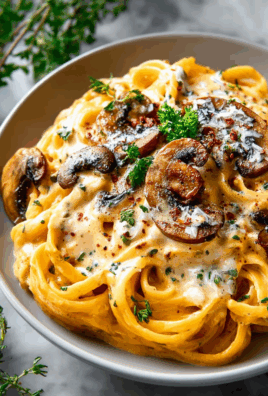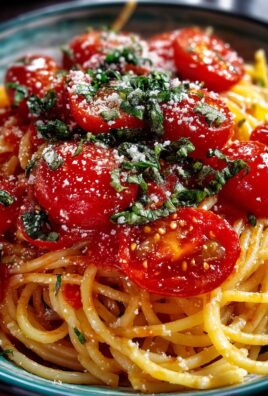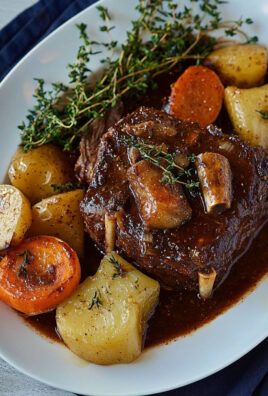French Vegetable Stew, or Ratatouille as it’s known in France, is more than just a dish; it’s a vibrant celebration of summer’s bounty in a bowl! Imagine tender eggplant, sweet bell peppers, juicy tomatoes, and fragrant zucchini, all simmered together in a rich, herby tomato sauce. Are you ready to transport your taste buds to the sunny fields of Provence?
This classic dish hails from the Nice region of France and was originally a peasant dish, a way to use up the season’s ripe vegetables. Over time, it has evolved from simple sustenance to a culinary icon, appearing in countless cookbooks and even inspiring a beloved animated film. But its heart remains the same: fresh, seasonal vegetables cooked with love and care.
What makes French Vegetable Stew so irresistible? It’s the perfect combination of textures and flavors. The vegetables retain a slight bite, offering a delightful contrast to the smooth, flavorful sauce. It’s also incredibly versatile! Enjoy it as a light lunch, a hearty side dish, or even as a topping for pasta or grilled bread. Plus, it’s naturally vegan and gluten-free, making it a crowd-pleaser for all dietary needs. So, let’s get cooking and bring a little bit of French sunshine to your table!
Ingredients:
- 2 tablespoons olive oil
- 1 large onion, chopped
- 2 cloves garlic, minced
- 2 carrots, peeled and chopped
- 2 celery stalks, chopped
- 1 leek, white and light green parts only, thoroughly cleaned and sliced
- 1 red bell pepper, seeded and chopped
- 1 yellow bell pepper, seeded and chopped
- 1 zucchini, chopped
- 1 yellow squash, chopped
- 1 (14.5 ounce) can diced tomatoes, undrained
- 4 cups vegetable broth
- 1 cup green beans, trimmed and halved
- 1 cup frozen peas
- 1/2 cup chopped fresh parsley
- 1/4 cup chopped fresh basil
- 1 teaspoon dried thyme
- 1/2 teaspoon dried rosemary
- Salt and freshly ground black pepper to taste
- Crusty bread, for serving (optional)
Preparing the Vegetables:
Before we even think about turning on the stove, let’s get all our vegetables prepped and ready to go. This makes the cooking process so much smoother and more enjoyable. Trust me, you’ll thank yourself later!
- Chop the Onion: Start by peeling and chopping the onion. I like to dice mine into small, even pieces so they cook evenly. Don’t worry about being perfect, just aim for consistency.
- Mince the Garlic: Next, mince the garlic. Fresh garlic is key to a flavorful stew, so don’t skimp on this step. You can use a garlic press or finely chop it with a knife.
- Prepare the Carrots and Celery: Peel and chop the carrots and celery. I usually cut them into similar-sized pieces as the onion for a uniform look and cooking time.
- Clean and Slice the Leek: Leeks can be tricky because they often have dirt trapped between their layers. To clean them properly, slice the leek lengthwise and then rinse it thoroughly under cold water, making sure to remove any grit. Then, slice the white and light green parts into thin rounds.
- Chop the Bell Peppers: Seed and chop both the red and yellow bell peppers. I like to remove the white membranes inside the peppers as well, as they can sometimes be a bit bitter.
- Chop the Zucchini and Yellow Squash: Finally, chop the zucchini and yellow squash into bite-sized pieces. There’s no need to peel them unless you prefer to.
Sautéing the Aromatics:
Now that all our vegetables are prepped, it’s time to build the flavor base of our stew. Sautéing the aromatics in olive oil releases their essential oils and creates a delicious foundation for the rest of the ingredients.
- Heat the Olive Oil: In a large pot or Dutch oven, heat the olive oil over medium heat. You want the oil to be shimmering but not smoking.
- Sauté the Onion, Carrots, and Celery: Add the chopped onion, carrots, and celery to the pot. Sauté for about 5-7 minutes, or until the onion is translucent and the vegetables are slightly softened. Stir occasionally to prevent them from sticking to the bottom of the pot.
- Add the Garlic and Leek: Add the minced garlic and sliced leek to the pot. Sauté for another 1-2 minutes, or until the garlic is fragrant. Be careful not to burn the garlic, as it can become bitter.
Adding the Remaining Vegetables and Liquids:
With the aromatics nicely sautéed, it’s time to add the rest of the vegetables and the liquids that will form the base of our stew. This is where the magic really starts to happen!
- Add the Bell Peppers, Zucchini, and Yellow Squash: Add the chopped bell peppers, zucchini, and yellow squash to the pot. Stir to combine with the other vegetables.
- Add the Diced Tomatoes: Pour in the can of diced tomatoes, undrained. The tomatoes will add acidity and depth of flavor to the stew.
- Pour in the Vegetable Broth: Pour in the vegetable broth. Make sure the broth covers all the vegetables. If not, you can add a little more.
- Add the Dried Herbs: Add the dried thyme and dried rosemary to the pot. These herbs will infuse the stew with a warm, earthy flavor.
- Season with Salt and Pepper: Season the stew with salt and freshly ground black pepper to taste. Remember that you can always add more seasoning later, so it’s best to start with a smaller amount and adjust as needed.
Simmering the Stew:
Now comes the most important part: simmering the stew. This allows all the flavors to meld together and the vegetables to become tender. Patience is key here!
- Bring to a Boil: Bring the stew to a boil over medium-high heat.
- Reduce Heat and Simmer: Once the stew is boiling, reduce the heat to low, cover the pot, and simmer for at least 30 minutes, or until the vegetables are tender. The longer you simmer the stew, the more flavorful it will become. I often let mine simmer for an hour or more.
- Stir Occasionally: Stir the stew occasionally to prevent it from sticking to the bottom of the pot.
Adding the Final Touches:
With the stew nicely simmered, it’s time to add the final touches that will elevate it to the next level. These additions will brighten the flavors and add a fresh, vibrant element to the dish.
- Add the Green Beans and Peas: Add the green beans and frozen peas to the pot. Stir to combine.
- Cook Until Tender: Cook for another 5-10 minutes, or until the green beans are tender-crisp and the peas are heated through.
- Stir in the Fresh Herbs: Stir in the chopped fresh parsley and basil. These herbs will add a burst of freshness to the stew.
- Taste and Adjust Seasoning: Taste the stew and adjust the seasoning as needed. You may want to add more salt, pepper, or herbs to suit your taste.
Serving the Stew:
Finally, it’s time to serve our delicious French vegetable stew! This stew is perfect on its own, but it’s even better served with a side of crusty bread for dipping. You can also garnish it with a dollop of crème fraîche or a sprinkle of Parmesan cheese, if desired.
- Ladle into Bowls: Ladle the stew into bowls.
- Garnish (Optional): Garnish with a dollop of crème fraîche or a sprinkle of Parmesan cheese, if desired.
- Serve with Crusty Bread: Serve with crusty bread for dipping.
- Enjoy! Enjoy your delicious and healthy French vegetable stew!
Tips and Variations:
Here are a few tips and variations to help you customize this recipe to your liking:
- Add Potatoes: For a heartier stew, add diced potatoes along with the carrots and celery.
- Use Different Vegetables: Feel free to substitute other vegetables based on what you have on hand or what’s in season. Some good options include mushrooms, turnips, and parsnips.
- Add Beans: For extra protein, add a can of drained and rinsed cannellini beans or kidney beans.
- Make it Spicy: Add a pinch of red pepper flakes or a dash of hot sauce for a little kick.
- Use Wine: For a richer flavor, deglaze the pot with a splash of dry white wine after sautéing the aromatics.
- Make it Vegan: Ensure your vegetable broth is vegan-friendly.
Storage Instructions:
Leftover stew can be stored in an airtight container in the refrigerator for up to 3-4 days. It can also be frozen for longer storage. To reheat, simply warm the stew in a pot over medium heat or in the microwave.

Conclusion:
This isn’t just another stew recipe; it’s a culinary journey to the heart of French countryside cooking. The vibrant flavors, the comforting aroma, and the sheer simplicity of preparation make this French Vegetable Stew an absolute must-try for anyone looking to add a touch of elegance and wholesome goodness to their meals. I truly believe that once you taste the rich, layered flavors of this dish, it will become a staple in your kitchen, a go-to recipe for cozy nights and impressive gatherings alike.
But what truly sets this stew apart is its versatility. While I’ve presented a classic rendition, feel free to experiment and make it your own! For a heartier meal, consider adding some cannellini beans or chickpeas during the last 30 minutes of cooking. They’ll soak up the delicious broth and add a satisfying protein boost. If you’re a meat-lover, small cubes of sautéed chicken or sausage would also be a fantastic addition, transforming it into a substantial one-pot wonder.
Serving suggestions are endless! I personally love to ladle a generous portion of this stew over a bed of fluffy couscous or quinoa. The grains perfectly complement the tender vegetables and soak up all that flavorful broth. A crusty baguette, perfect for dipping, is also an absolute must. And for a truly authentic French experience, a dollop of crème fraîche or a sprinkle of fresh herbs like parsley or thyme will elevate the dish to another level.
For a lighter, more summery version, you can swap out some of the root vegetables for zucchini, yellow squash, and bell peppers. A squeeze of fresh lemon juice at the end will brighten the flavors and add a refreshing zing. And if you’re feeling adventurous, a pinch of saffron threads will impart a beautiful golden hue and a subtle, exotic aroma.
Don’t be intimidated by the seemingly long list of ingredients. The beauty of this recipe lies in its forgiving nature. Feel free to adjust the quantities to your liking and substitute vegetables based on what’s in season or what you have on hand. The most important thing is to use fresh, high-quality ingredients and to let the flavors meld together slowly and patiently.
Why You’ll Love This French Vegetable Stew
This recipe is more than just a list of instructions; it’s an invitation to create something truly special. It’s a chance to connect with the simple pleasures of cooking, to nourish your body with wholesome ingredients, and to share a delicious meal with loved ones. I’ve poured my heart and soul into perfecting this recipe, and I’m confident that you’ll love it as much as I do.
So, what are you waiting for? Gather your ingredients, put on some music, and get ready to embark on a culinary adventure. I promise you, the end result will be well worth the effort. And most importantly, don’t be afraid to have fun and experiment! Cooking should be a joyful experience, and this French Vegetable Stew is the perfect canvas for your culinary creativity.
I’m so excited for you to try this recipe! Once you do, please come back and share your experience in the comments below. I’d love to hear about your variations, your serving suggestions, and any tips or tricks you discovered along the way. Let’s create a community of passionate cooks who share a love for delicious, wholesome food. Bon appétit!
French Vegetable Stew: A Delicious & Easy Recipe
A hearty and flavorful French vegetable stew, packed with fresh vegetables and aromatic herbs. Perfect for a healthy and comforting meal.
Ingredients
- 2 tablespoons olive oil
- 1 large onion, chopped
- 2 cloves garlic, minced
- 2 carrots, peeled and chopped
- 2 celery stalks, chopped
- 1 leek, white and light green parts only, thoroughly cleaned and sliced
- 1 red bell pepper, seeded and chopped
- 1 yellow bell pepper, seeded and chopped
- 1 zucchini, chopped
- 1 yellow squash, chopped
- 1 (14.5 ounce) can diced tomatoes, undrained
- 4 cups vegetable broth
- 1 cup green beans, trimmed and halved
- 1 cup frozen peas
- 1/2 cup chopped fresh parsley
- 1/4 cup chopped fresh basil
- 1 teaspoon dried thyme
- 1/2 teaspoon dried rosemary
- Salt and freshly ground black pepper to taste
- Crusty bread, for serving (optional)
Instructions
- Prepare the Vegetables: Chop the onion, mince the garlic, peel and chop the carrots and celery. Clean and slice the leek. Seed and chop the bell peppers. Chop the zucchini and yellow squash.
- Sauté the Aromatics: Heat olive oil in a large pot or Dutch oven over medium heat. Add onion, carrots, and celery; sauté for 5-7 minutes until softened. Add garlic and leek; sauté for 1-2 minutes until fragrant.
- Add Remaining Vegetables and Liquids: Add bell peppers, zucchini, and yellow squash to the pot. Stir in diced tomatoes (undrained) and vegetable broth. Add dried thyme and rosemary. Season with salt and pepper.
- Simmer the Stew: Bring to a boil, then reduce heat to low, cover, and simmer for at least 30 minutes (or longer for more flavor) until vegetables are tender, stirring occasionally.
- Add Final Touches: Add green beans and frozen peas; cook for 5-10 minutes until tender-crisp. Stir in fresh parsley and basil. Taste and adjust seasoning.
- Serve: Ladle into bowls. Garnish with crème fraîche or Parmesan cheese (optional). Serve with crusty bread.
Notes
- For a heartier stew, add diced potatoes along with the carrots and celery.
- Feel free to substitute other vegetables based on what you have on hand or what’s in season. Some good options include mushrooms, turnips, and parsnips.
- For extra protein, add a can of drained and rinsed cannellini beans or kidney beans.
- Add a pinch of red pepper flakes or a dash of hot sauce for a little kick.
- For a richer flavor, deglaze the pot with a splash of dry white wine after sautéing the aromatics.
- Ensure your vegetable broth is vegan-friendly.
- Leftover stew can be stored in an airtight container in the refrigerator for up to 3-4 days. It can also be frozen for longer storage. To reheat, simply warm the stew in a pot over medium heat or in the microwave.





Leave a Comment